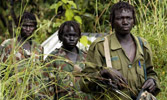
The U.S. Congress is scheduled to unveil a new strategy aimed at dismantling the Lord’s Resistance Army this Wednesday, November 24. The LRA Disarmament and Northern Uganda Recovery Act, signed into law by President Obama in May, gave his administration 180 days to devise a comprehensive plan to better protect civilians and “eliminate the threat” of the LRA.
The precise details of the strategy won’t be clear until Wednesday or perhaps even later, and some portions will almost certainly be classified. The process leading to the completion of the strategy has been commendable. Laudable efforts were made on the part of State Department and U.S. army officials to gather information from all actors involved in working on the LRA whose policy prescriptions range from sending in the U.S. marines after Kony to resuming peace talks with the LRA. However, it is likely that the new U.S. strategy will disappoint many, especially given the high expectations created as a result of the broad participation of stakeholders in the information gathering stage.
It appears the strategy will mostly continue the current course with beefed up support to the on-going Ugandan army offensive against LRA groups in Congo, Central African Republic, and Sudan. Increased U.S. financial and logistical support as well as increased intelligence will be dedicated to the Ugandan army effort. Among other things, there may be provisions to improve infrastructure, such as roads and airstrips, in LRA affected areas. Most notably, U.S. technical personnel, both military and civilian contractors, will also be dispatched on the field of operations, which indicates a willingness on the part of the Obama administration to assume a more hands on approach. But neither ‘boots on the ground’ nor peace talks seem to have been taken on as viable options in the strategy.
It is unrealistic and perhaps unfair to expect the U.S. government to provide a quick solution to a very long conflict where a combination of both stick and carrots approaches have been used in the past, mostly with little success. And while the merits of the new strategy can be discussed in greater detail once it is unveiled, actual events on the ground – which are worrying as always – might soon put the new U.S. strategy to the test.
Rumors have started that LRA groups in Congo are preparing for what has become their now annual December attacks. In December 2008 and December 2009, LRA groups killed approximately 900 and 300 civilians respectively. While the late December 2008 attacks were perpetrated in response to a Ugandan army offensive against LRA bases on December 14, the reason for the December 2009 killings remains obscure.
A former LRA fighter told Enough recently that the attacks in December 2009 were carried out by a group of soldiers under commander Dominic Ongwen’s orders. “I don’t know why so many people were killed,” he said. “But I remember that we were living under difficult circumstances then, we had no food and medicine, and Dominic ordered for food and recruits to be taken.” Asked whether he thought the December attacks could be replicated this year, the former fighter answered, “Maybe. The group has been suffering due to [a recent joint] Ugandan and Congolese army attacks and Dominic is angry. He wants to show he is still strong.”
People abducted earlier this month near the town of Bangadi in Haut Uele province managed to escape and reported that LRA fighters had asked them about military positions, triggering fears of imminent LRA attacks. “We fear a repeat of the December attacks,” a local priest told Enough, adding, “it was the same last year and they killed many people.”
Last December, a host of international organizations, including Enough, warned that LRA attacks in Haut Uele were imminent based on testimony from people abducted by the rebels who were told that “the LRA would come celebrate Christmas” with them, a reference to the 2008 December attacks. A deployment of U.N. peacekeepers to the worst affected LRA areas in Bangadi, Ngilima, and Niangara in Haut Uele might have prevented attacks there. But, earlier and further south than expected, the LRA launched attacks on December 14 and 15 in Makombo in Haut Uele.
Given this pattern of attacks and the current locations of some LRA groups in northeastern Congo, it would be unwise to downplay the possibility of further attacks this December. Policymakers in charge of designing and implementing the U.S. strategy must take this history into account and prepare accordingly. In the tragic event that December attacks do happen, the newly unveiled U.S. strategy will face its first test, and serious questions about the chosen course of action will be asked.
Photo: LRA fighters (AP)

